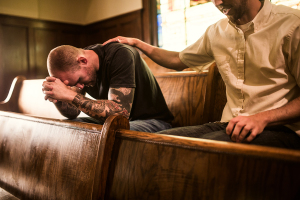6 Critical questions for the rural church in an age of social distancing

Recently, in a phone conference, someone used the analogy that becoming a virtual church is like playing chess without the queen.
The struggle is that in all our seminary education, the focus has always been on how to properly use the queen. But with the rapid changes occurring we have been forced in a matter of a couple of weeks to transition from being an onsite church to be a completely virtual church. For the rural church, this has placed us in completely uncharted waters.
While many large urban churches have been utilizing online and virtual services for some time, for most rural church this is something new. Not only are we struggling to learn how to broadcast our services live via social media, but we also face the challenge of being in communities where the people do not have access to social media platforms or, if they do, the technology is marginal to provide the internet speed necessary to conduct a service.
Nevertheless, the rural church possesses some very distinct advantages that make it better prepared and equipped to maintain its ministry in an age of social distancing. While we may not have all the access to the technology, we do have interpersonal connections enabling us to provide personal care for people in the congregation and community. In this case, our smallness becomes a significant advantage because we can still provide individual care. Not only do we know every attendee, but we are able to still make personal contact with everyone in the church on a regular basis. Rather than focus on what we are lacking, we can instead focus on our strengths and utilize them for our advantage.
However, as we navigate this new reality there are still six basic questions we must wrestle with. These are not new questions but age-old questions that we must now address in this new setting and in creative ways. The questions remain the same, but the mechanisms by which we answer these questions now require new solutions.
1. How are we going to shepherd the people?
Throughout scripture the call of church leadership is to be shepherds of the church. Our calling is not to run programs nor is it even to develop efficient organizational structures (although these are important), our calling is to care for the people we are called to serve.
When Peter wrote to the leaders of the church in Asia Minor, he challenged them to first and foremost “shepherd the flock of God among you” (1 Peter 5:2). This was not something unique to Peter but was an outgrowth of the exhortation that Christ himself gave Peter when reaffirmed Peter’s call to ministry in John 21:15-17. Twice he states “feed” and once he gives the command “shepherd My sheep.”
This becomes our primary role — caring and feeding the people we serve. Part of the way Paul and Peter accomplished this ministry was through the letters they sent to the various churches. Caring for people goes beyond the walls of the church and even beyond face-to-face contact.
As we navigate the new reality of ministry, we need to develop creative ways to communicate and care for people. We can provide care through text messages, sharing a daily devotional, using social media to record and then share a video, and providing links for people to go listen to a message that we or someone else recorded. We can make personal phone calls, sharing a verse and praying with them.
2. How can we maintain a sense of community through social distancing?
People need fellowship and companionship. God states in the very beginning of creation “it is not good for man to be alone.” God is a triune God who lives in eternal community.
Fellowship is intrinsic in the trinity and he created to reflect this community when he created us as relational beings. We see this also in the call to be the church. Intrinsic in God’s redemptive activity was placing us in a community where there would be mutual care, inner-connectiveness and accountability.
But the body of Christ is more than just a gathering once a week to sing songs of worship and listen to a sermon from the scriptures. The body of Christ is a living organism that involves the sharing of a mutual life, a life that encompasses the totality of our being. This brings us to the heart of fellowship.
While we practice social distancing to prevent the spread of the virus, we need to recognize that social isolation will be equally as destructive. The question we need to wrestle with is this: How do we connect with people in time of social distancing? How do we live out the call to be in a mutually caring community when we are required to maintain our distance? This is not an easy question to answer, but one that we need to carefully think through.
In many ways, the requirement of social distancing is forcing us to think creatively about community building. Too often we have placed all our focus upon fellowship on Sunday morning but not recognizing the importance of fellowship and community through the week.
This is why this question is so critical, for it not only is necessary for the present, but it is necessary for the future health of the church as well. Having the board members call each family in the church once a weak, developing online prayer groups, if the technology allows, having small groups get together on Zoom or Webex are ways to help people connect with one another.
3. How can we minister to each individual as they experience the struggles in this crisis?
In the ministry we sometimes become so focused on the whole group that we fail to minister to the individual. This can especially be true with the social distancing and the challenges to become virtual. As we work to address the worship service and deal with the challenges of developing a virtual ministry, we must also remember that we need to minister to each individual as they experience the crisis.
To do so we must recognize that not everyone is going to have the same needs. For some, the events that occur are merely an inconvenience to their daily life, for others it can be life altering. For some, social isolation has a minimal impact on their emotional and spiritual well-being, for others, the impact will be profound.
While developing structures and ministries to address congregational issues, we also need to keep in focus each individual. But this also gives us new opportunities within the community. As people who don’t normally attend church tune into our online messages and services, we need to be creative to identify and assist them. This is where the rural church can shine.
While we may struggle with providing a polished worship service electronically, we do have the capacity and relationships to minister to people as individuals. This will include, but not be limited to, people who live alone and elderly who do not have family nearby to help them with shopping and errands. Be cognizant of the people who are facing important needs within the community.
4. How can we provide an effective worship service to the people when we cannot gather corporately?
Perhaps the greatest challenge for rural churches is providing an effective worship service. While many have internet, in many rural areas the internet bandwidth may not be fast enough to handle online streaming. Dealing with online technology can be challenging (both for the pastor and the congregation).
However, we need to understand that worship is not entertainment and a quality worship service with the congregation can be possible even when the technology is lacking. Many churches are discovering new ways to connect creatively with people on Sunday morning. Solutions people are using include using a smart phone to broadcast a sermon from the office of the pastor, using online meeting sites such as Zoom, Webex and a host of others, prerecording messages and then putting them on Facebook or the church website.
Other options might include recording the message and then making it available to people with inexpensive MP3 players. Some have found a “drive-in” worship service to be effective, where they broadcast the message on a low power FM radio transmitter to people in cars in the parking lot to be relatively inexpensive but effective.
The most important principle to remember is that it is not the quality of the production that matters, but the quality of connection with people and speaking to their needs and concerns. Rather than looking at the resources that are not available, we need to creatively use the resource we have.
5. What are the physical needs of people in the church and in the community that we can help serve?
In times of crisis, people face greater struggles where they need assistance. Many are losing their job because of the service industry and tourist industry have been shut down. Others, such as the shut in and the elderly, are having difficulty obtaining necessary groceries, prescriptions and doctor visits. Because they are highly at risk, it is critical that they practice social distancing.
However, because they do not have anyone to assist them, they need others to run errands for them. As the crisis continues to impact people, it is important that the church not only be aware of the physical needs of people within the congregation, but also within the community. This provides the church an opportunity to impact their community as their ministry to those in the community who have needs. This opens new opportunities to share the gospel.
6. How can we prevent congregational drift?
One of the greatest concerns in this time of social isolation where people are not connecting with others in the church is that people can begin to drift away from the church. Because there is no longer a Sunday gathering to keep them connected to the church community, they can slowly drift away.
Especially at risk are the people who had a marginal attachment to the church to begin with. Consequently, the board and pastor need to work together to develop creative ways to keep connected with everyone in the congregation and prevent congregational drift.
This may include physical calls to people weekly, connecting everyone via Facetime or other electronic gathers. It may involve some visitation where we remain outside and maintain our physical distance, but still connect with others.
Certainly, these are challenging times requiring us to think creatively and outside the box in determining new and creative ways to build the church. On the other hand, this may be the very thing we needed the most to get us outside the church walls and back into the communities we are called to serve.
In the end, when we finally can reconnect physically as a church, we may have discovered new and innovative ways to do ministry, transforming us to be more effective and intentional in ministry. For a time, we may not be able to have the queen, but it may teach us to play more effective with the other pieces. We are faced with a unique opportunity where we can no longer operate the church by the traditional ways we have done ministry. In the end, this may be a good thing.
Glenn Daman is pastor of a rural church and author of five books on rural and small church ministry.



























